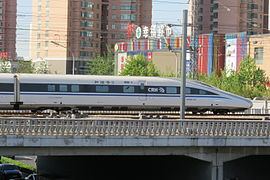Type High-speed rail Opened December 26, 2012 Stations 46 | Status Operational Rolling stock CRH380A series | |
 | ||
Termini Beijingxi Station
(further: Fengtai Station)
West Kowloon Terminus Depot(s) Beijing MU Depot
Shijiazhuang MU Depot
Zhengzhou MU Depot
Wuhan MU Depot
Changsha MU Depot
Guangzhou MU Depot
Shenzhen MU Depot
Shek Kong Depot Owners China Railway, MTR Corporation Locale Beijing, Hebei, Henan, Hubei, Hunan, Guangdong Province, Hong Kong Operators China Railway High-speed, MTR Corporation | ||
The Beijing–Guangzhou–Shenzhen–Hong Kong High-Speed Railway or Jingguangshengang High-Speed Railway from its Chinese name (simplified Chinese: 京广深港高速铁路; traditional Chinese: 京廣深港高速鐵路) is a high-speed railway of the CRH passenger service, ultimately connecting Beijingxi Station in Beijing and Futian Station in Shenzhen. It will then cross the border and follow the Guangzhou–Shenzhen–Hong Kong Express Rail Link Hong Kong section to West Kowloon Station in Hong Kong. When finished, it will be 2,230 kilometres (1,390 mi) long, and will be the only Chinese high-speed railway to cross a border that requires immigration and customs clearance. The existing, conventional Jingguang railway runs largely parallel to the line.
Contents
History
Construction started in 2005. The Wuhan–Guangzhou section opened in December 2009, the Guangzhou–Shenzhen section opened in December 2011, the Zhengzhou–Wuhan section opened in September 2012, and the Beijing–Zhengzhou section was opened in December 2012. The 36-kilometre (22 mi) cross-border Shenzhen–Hong Kong section is expected to open in the third quarter of 2018. The line is the world's longest high-speed rail route. The high speed rail line cuts travel time by more than half.
Through-services with other high-speed lines
Besides trains running between Beijing, Shijiazhuang, Zhengzhou, Wuhan, Changsha, Guangzhou and Shenzhen, the railway also has direct service with other connecting high-speed lines. The direct Xi'an–Zhengzhou–Wuhan–Guangzhou–Shenzhen service started simultaneously with the opening of the Zhengzhou–Wuhan section in September 2012, as well as the direct interline service Xi'an-Zhengzhou–Beijing, Taiyuan–Shijiazhuang–Guangzhou, Taiyuan–Shijiazhuang–Wuhan–Guangzhou. Future connections will include Fujian province destinations and possibly Hangzhou with testing of the Hangzhou–Fuzhou–Shenzhen High-Speed Railway commencing and soon to open.
Connections to local transport
To minimize disruptions to existing urban areas and provide large curve radii, the Beijing–Guangzhou High-Speed Railway, similar to other such railways in China, was constructed in an alignment somewhat different from the existing Beijing–Guangzhou Railway. In most cities served by the high-speed railway, its trains stop at stations built specifically for the new line, which are away from the urban core and the city's conventional railway station. In some of the larger cities, it may take more than an hour to ride a bus or taxi from the city centre to the high-speed rail station.
Most of the cities involved have improved the public transit access to the new high-speed rail stations, or plan to do so. Guangzhounan Station is already served by Guangzhou Metro and Beijingxi Station served by Beijing Metro. Wuhan Station is served by Wuhan Metro's Line 4, which opened in December 2013. Zhengzhoudong Station will be served by the future Zhengzhou Metro, and Shijiazhuang Station, by the future Shijiazhuang Metro.
Transfers to other rail lines
Guangzhounan Station and Wuhan Station are designed as hubs for several high-speed railway (HSR) lines. Frequent service to Zhuhai is available at Guangzhou South, while a connection to Yichang can be made at Wuhan.
Although the Beijing–Guangzhou HSR largely parallels the older conventional Beijing–Guangzhou line, most of the HSR stations are located away from the local conventional train stations. Therefore, direct transfer to conventional (not high-speed) trains is possible only at a few stations along the route. Among them are Beijingxi (which is one of the nation's main passenger railway hubs), Shijiazhuang, Wuhan (which has a few conventional trains, although fewer than the city's two other stations, at Hankou and Wuchang), and Guangzhoubei.
Immigration clearance
As Hong Kong is a Special Administrative Region, the Shenzhen-Hong Kong portion of the high speed rail will pass through an immigration control point, and as of early 2013, the details of how immigration control will work have not been finalized. Although the West Kowloon Terminus is designed to allow both Mainland and Hong Kong officials to conduct immigration control in Hong Kong, there is a constitutional issue as Mainland officials do not have the constitutional authority to enforce Mainland law in Hong Kong.
Sections
Operational lines in the table below are marked with green background.
Station list
Major railway stations are in bold.
